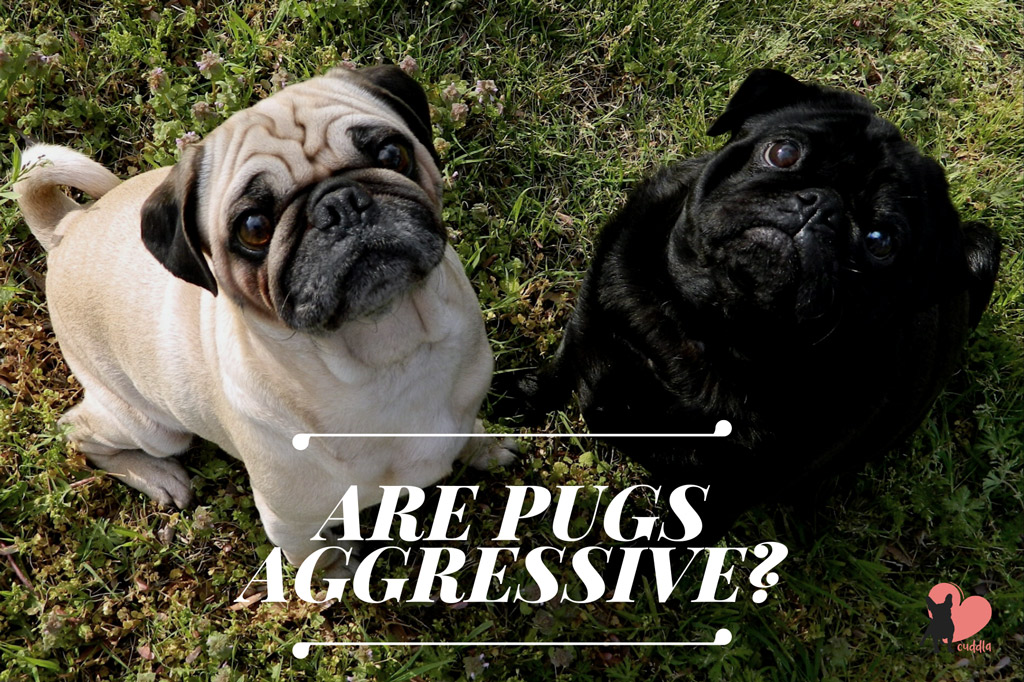
If you are considering the Pug breed as a family or companion dog, understanding the Pug’s temperament is key. Are Pugs aggressive dogs?
Although Pugs have a friendly temperament, they can become aggressive when not properly socialized and trained. Pugs can show aggression by barking, growling, lunging or nipping.
Let’s look into what makes Pugs aggressive and how to change unwanted behaviours.
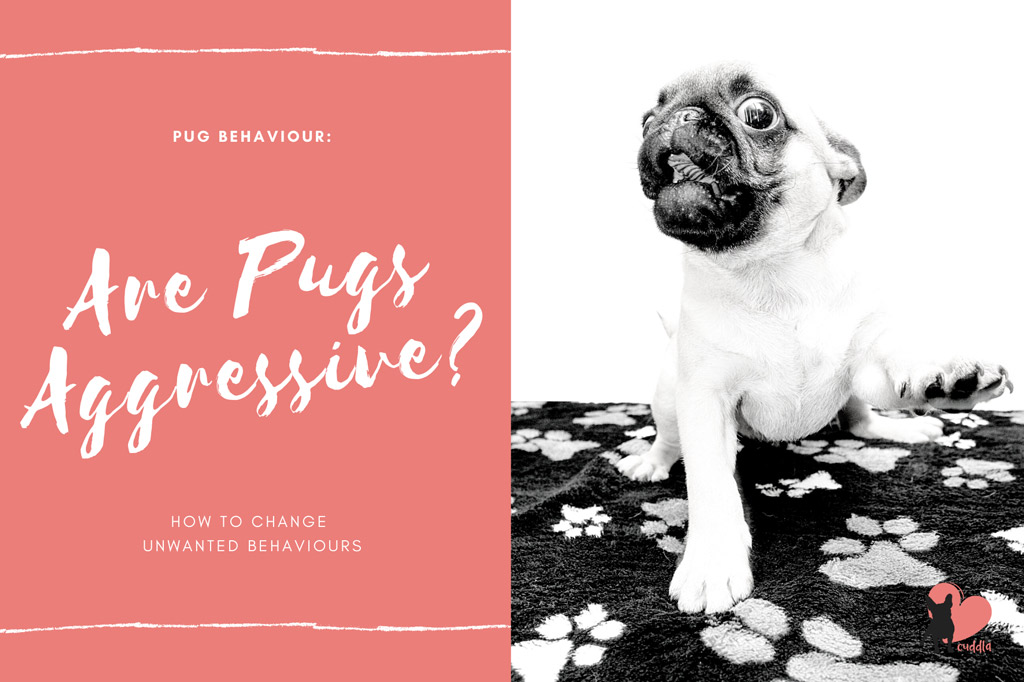
Are Pugs Aggressive Dogs?
Before looking into why Pugs can become aggressive, let’s have a look at Pug’s personality and temperament.
The AKC describes Pugs as an even-tempered dog in the official breed standards. Pugs’ temperament is playful, charming and outgoing. Pugs have a loving disposition.
Due to their playful and loving nature and being bred as companion dogs, Pugs are not prone to barking, digging or chewing (some of the most common dog behaviour problems). But, this doesn’t mean that they don’t get into any trouble.
Pugs are not usually aggressive towards other people, including seniors and kids, or pets. But that doesn’t mean it’s guaranteed to have a friendly dog, without going through proper dog socialization and training.
Dogs can become aggressive when not properly socialized or trained. We will get into the causes further down, but aggression in Pugs is often the result of a fear response.
Pugs can show aggression by barking, lunging, nipping, or growling. For instance, a Pug can be aggressive towards a kid by nipping their feet, lunging towards them or just barking at them.
Are Male Pugs Aggressive?
There aren’t significant differences recorded between male and female Pugs.
Rather than gender, it comes to socialization, training, the dog’s parents temperament and the dog’s previous experiences if adopted.
Some male Pugs will react to other males if competing for a female; something that you can experience in the park.
On the other hand, sometimes female Pugs will confront each other for leadership in between the two; a scenario you can come across if you own two female Pugs.
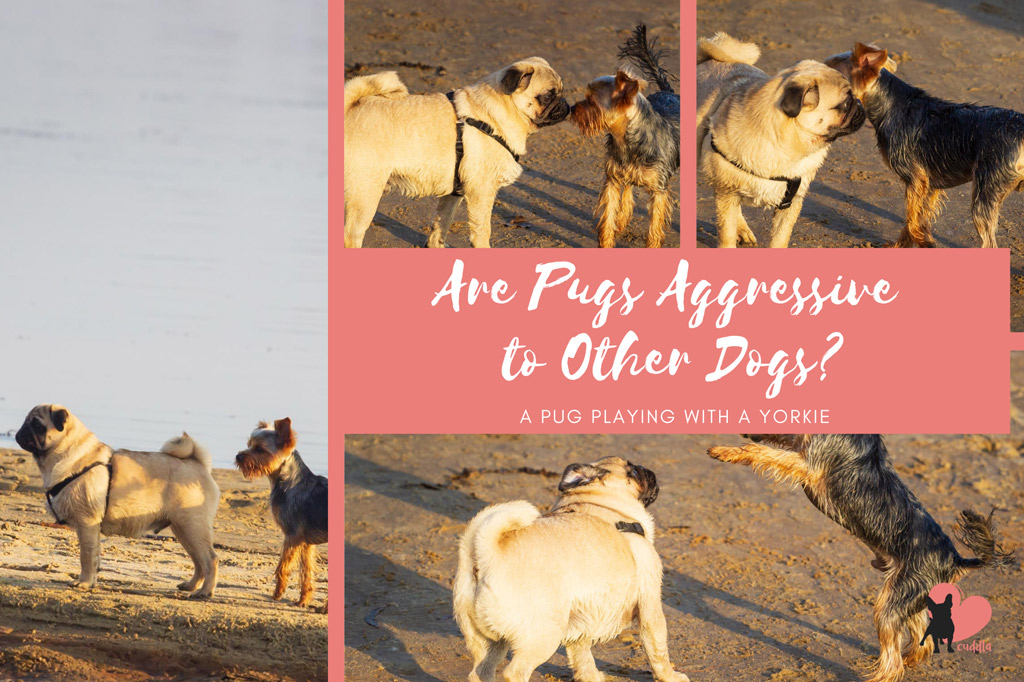
Are Pugs Aggressive to Other Dogs?
Pugs have a sociable temperament and tend to get along with other dogs (and cats). When you socialize your Pug from an early age (first 14 to 16 weeks of your puppy’s life) and continue to do so, your dog will develop a confident personality and have an outgoing temperament.
For those reasons, Pugs are friendly not only towards other Pugs but also towards other breeds.
If your Pug hasn’t interacted with other dogs, he will perceive other dogs as strangers and he may be aggressive towards the unfamiliar dogs.
A Pug will react adversely when he comes into contact with other dogs (and animals) due to his own anxiety and fear.
For your Pug to tolerate and not react to other dogs, he will need to be introduced to as many dogs as possible. This includes dogs from different breeds, ages and gender.
This will help him to communicate in a non-fearful or aggressive manner with others.
If you are bringing home a Pug puppy and you already have a dog or/and cat, you will need to introduce the new puppy to all the furry family members.
Let your pets interact whilst you are present, i.e., let them sniff, lick, or whatever they decide to do to get to know each other.
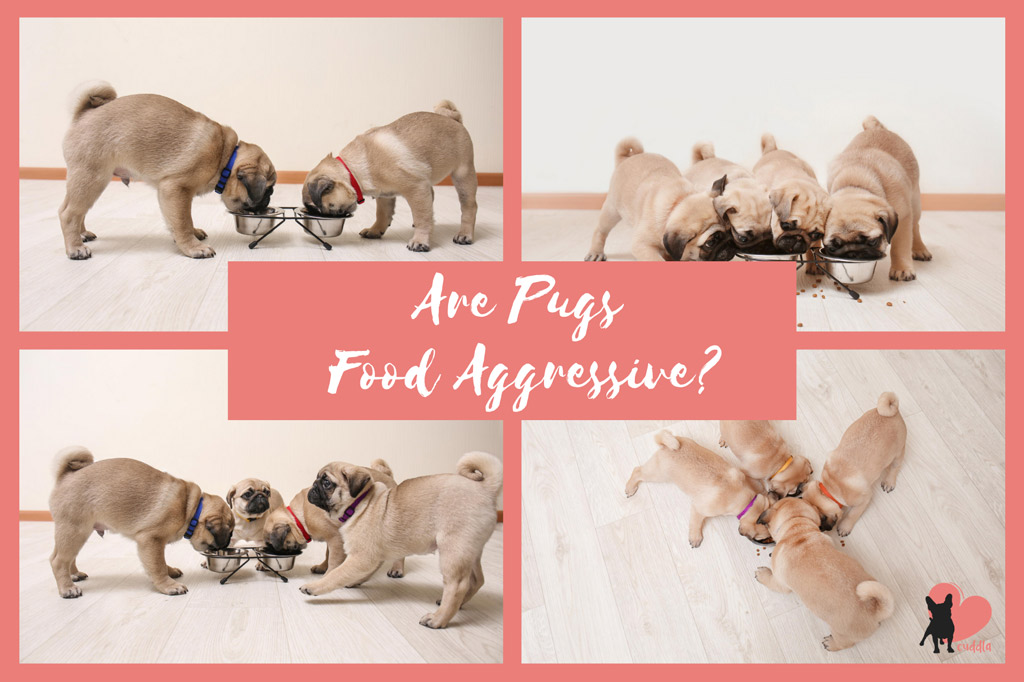
Are Pugs Food Aggressive?
Pugs love to eat! According to the AKC, Pugs are one of the 10 dog breeds that love to eat the most.
Knowing this, you might believe that they can be food aggressive dogs. However, it varies among individual dogs within this breed.
Rather than being possessive of their food, a dog that shows food aggression in just guarding a resource. This means that the dog believes he needs to defend and protect the food because it’s limited.
The belief of scarcity has to do with the dog’s previous experiences with food, the lack of it, and/or the need to fight or steal for it. This scenario is more common with rescue dogs that had a traumatic past, which I experienced with a foster Jack Russel Terrier cross.
Assuming that a Pug is getting enough food and good quality nutrition, he shouldn’t feel like there is a lack of food.
However, if a Pug hasn’t been trained or exposed to his owner and family handling his food and being okay with it, he might react if a family member approaches his bowl.
It’s important to hand feed your Pug and train him to be okay with his bowl being taken away by anyone in the household. This shouldn’t pose a threat to your dog.
Ideally, you are building a relationship set in trust.
Your Pug trusts that you will feed him and he will follow your commands or direction happily, knowing there’s a wonderful reward coming soon. 😉
Tootsie loves her food, but from day one she was okay with us handling the bowl, even when we were strangers to her.
If you are having trouble with food aggression, continue reading to find ways to deal with it.
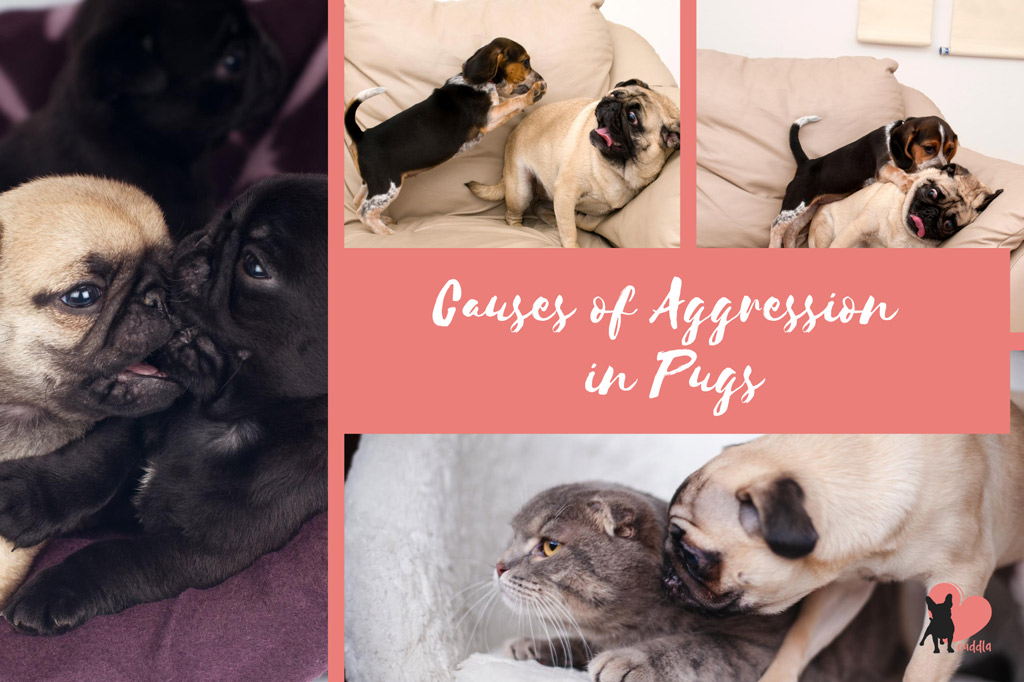
Causes of Aggression in Pugs
Why is your Pug suddenly aggressive?
If your Pug has exhibited signs of aggression, don’t panic! This unwanted behaviour can be changed. But first, you need to identify the cause or the trigger.
Before addressing aggressive behaviour, take your dog to a veterinarian for a complete physical examination since and illness could be the cause.
The causes of aggression in Pugs can vary greatly between dogs due to:
- Genetics: If one of the parents has an aggressive temperament, the pups can inherit the trait.
- Socialization: When a Pug is not properly socialized (i.e., has positive interactions with other dogs, people, children, and noises), he will react adversely when he comes into contact with them.
- Training: Learning how to interact with his human family, what is acceptable and what is not will shape your dog’s character, alongside proper socialization.
- Environment: Pugs that have been abused or frequently exposed to high-stress, traumatic situations may also develop aggressive behaviours.
- Experiences: A dog remembers his prior negative experiences and develops a fear response to it. For example, when a puppy is introduced to another dog and gets bitten, that puppy can develop a negative response towards meeting other dogs in the future because he remembers his prior negative experience.
Here are the different types of aggression to look for:
- Illness: Sometimes chemical imbalances such as low thyroid hormone levels or abnormalities of the liver can trigger aggression in dogs.
- Fear: Defensive aggression is due to fear or anxiety. The main cause of aggression in dogs is fear. Their body-language is submissive (they avoid direct eye contact, lower their head and body, tail between their legs, and ears back). But they may snap or bite if cornered.
- Possessiveness: Pugs can become jealous and possessive. For instance, your Pug is guarding resources. This behaviour comes from anxiety, fear or loss, and a desire to protect important resources such as food, toys, and sometimes even their human owner!
- Dominance: This is when male Pugs behave excessively confident in front of another male dog. They may try and make themselves look big, even a bit unfriendly. But it’s unlikely that the situation escalates to aggression.
How to Change Unwanted Behaviours
Although genetics play a part, you can highly influence your Pug’s temperament with proper socialization and training.
There are things that you, as an owner, can do to encourage your Pug to be friendly and confident when facing unknown situations, people and animals.
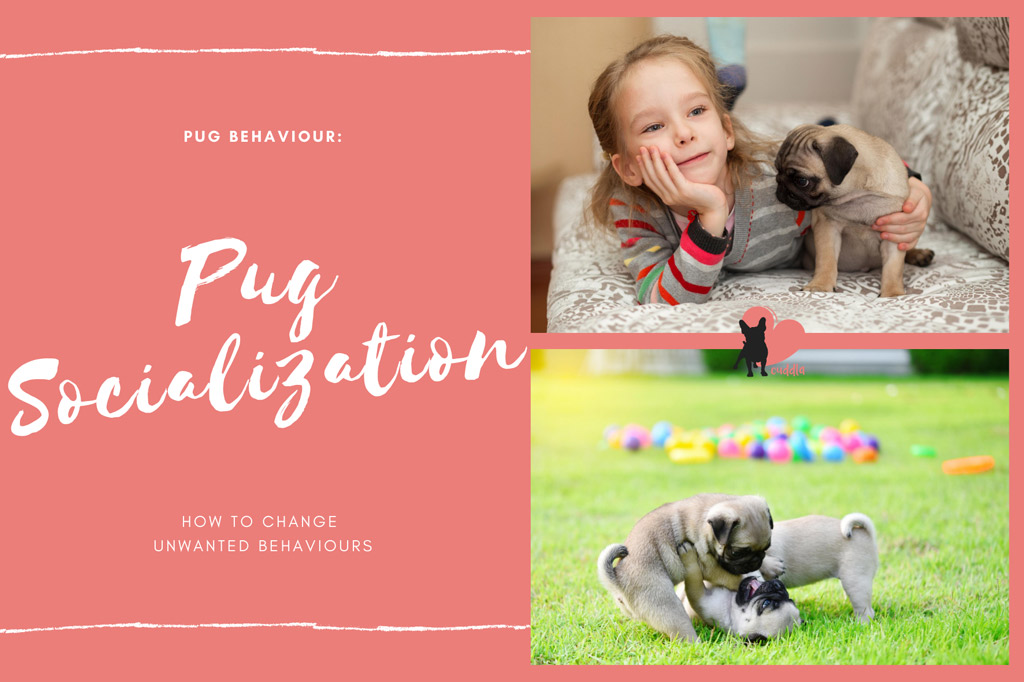
#1 – Socializing Your Pug
First of all, let’s see what socialization means.
Just like children, puppies are not born with social skills. They need to live and interact with their family (canine and/or human) to learn!
The American Veterinary Society of Animal Behavior has noted that the first three months of a puppy’s life is the most important time for socialization. So, a dog’s socialization period is the first 14 to 16 weeks of a puppy’s life. That’s the window of learning, i.e., socializing for your Pug puppy.
Socialization, in simple terms, means the process that a puppy must got through to learn key life skills to ensure a happy and confident behaviour in the pup’s environment. And also being able to communicate effectively within his social group.
This means your Pug puppy is comfortable around new people, pets and animals, and various places because you have exposed him to these experiences in a positive manner. You are teaching him that there really shouldn’t be much to fear.
One of the leading causes of aggression in dogs is fear.
If your dog hasn’t been exposed to a diversity of people, other dogs, animals, sounds, etc., he can develop unwanted behaviours like excessive barking, growling or nipping.
For instance, if a Pug is showing aggressive behaviours toward other humans, it’s likely that he’s just scared of them. Dogs that aren’t socialized with other humans only know the humans in their home, everyone else is a stranger to them.
Read also: Boston Terrier Socialization In 8 Steps [Plus Checklist] – the tips on this article also applies to other breeds, like Pugs.
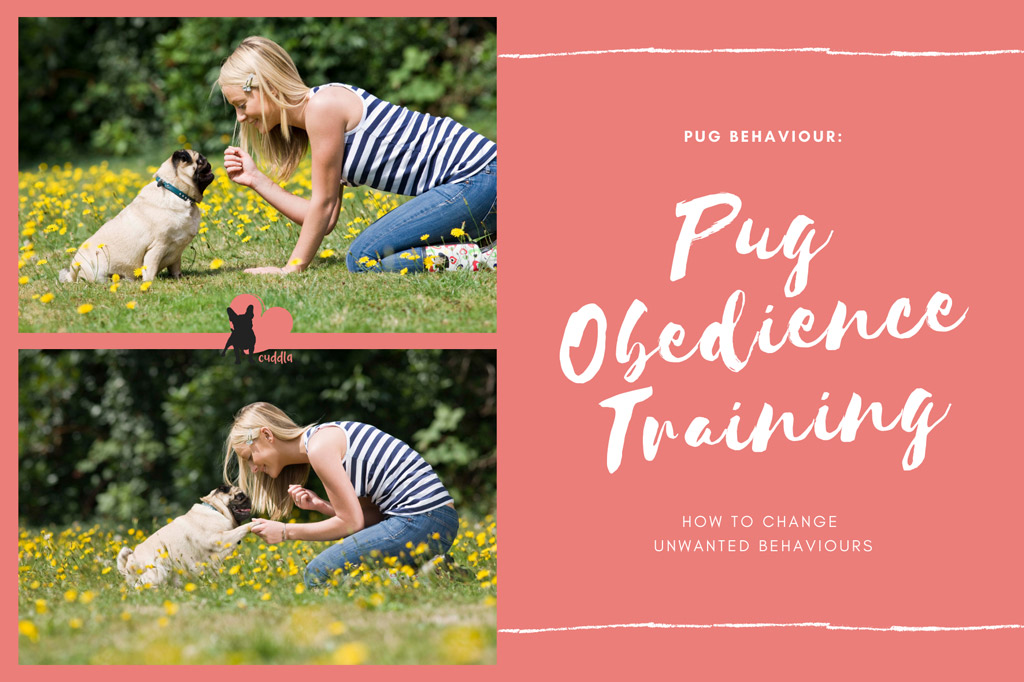
#2 – Training Your Pug
Pugs can be a little headstrong at times; they can be stubborn during training. Don’t let it put you off when you are training your pooch!
Obedience training requires patience, consistency and repetition – but in time you will get your Pug to follow your command and learn the house rules.
Training helps your dog to learn what to do and what not to do. Positive reinforcement training (or reward-based training) should be positive and motivational.
This type of training consists of rewarding your Pug’s good behaviour immediately after it happens with praise, a caress or a healthy treat. The big takeaway of this method is that it encourages your dog to repeat good behaviour.
Reward-based training also involves generally ignoring any ‘unwanted’ behaviours. If dogs are not rewarded (i.e. receives no attention or treats) for a certain behaviour, then they tend to stop doing it.
Insider Tip: Dogs interpret any attention (eye-contact, yelling or getting angry) as a reinforcement of behaviour. They will perceive a reaction from you as getting attention, and any form of attention/reaction from the owner is better than no reaction at all.
If your Pug’s unwanted behaviours persist, it’s time to check with a dog trainer – which I may be able to help with…
Click here to visit our Dog Training Essentials, where you will get a 3-part mini audio series + the everyday resource used by a well-known dog trainer.
A positive reinforcement training approach will help with:
- Teaching your dog good manners.
- Socialization, and how to continue to being sociable as they grow.
- Address bad behaviours that developed into habits like:
- Jumping
- Food stealing
- Chasing people
Consistent training, rewards and a better understanding of your dog’s body language will help you to prevent aggression.
You can also get this here. Happy training! 😉
